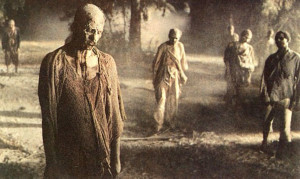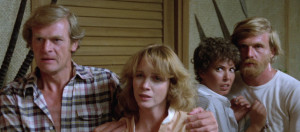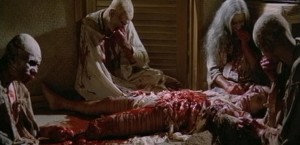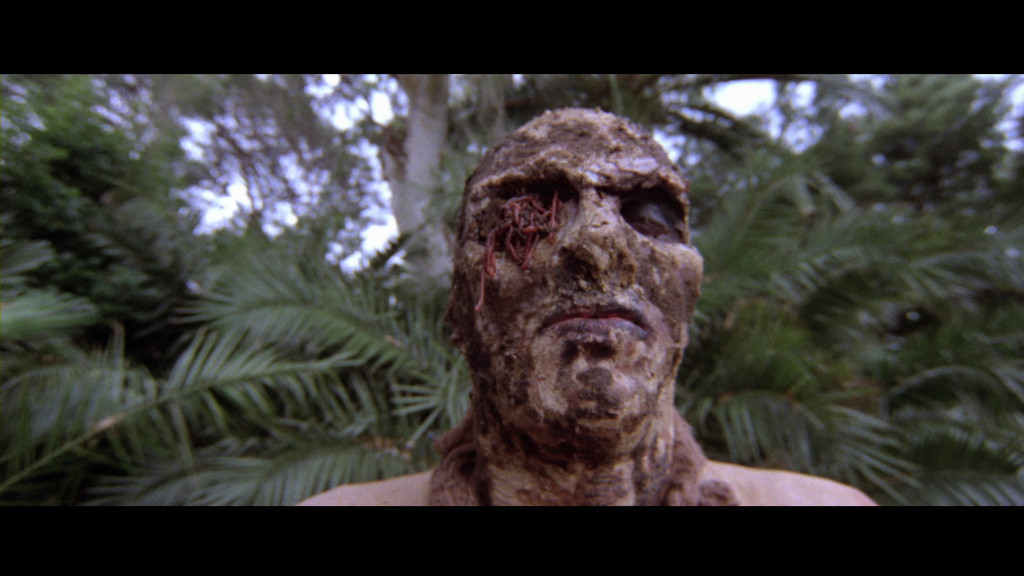A monumental and horrifying shift in pop culture happened during the ’60s and ’70s. Audiences were not scared by the same things anymore – they wanted to be frightened by blood, gore, and vicious creatures hungry for human flesh. The rise and birth of the zombie culture that we know so well today all began in the late ’60s with George A. Romero’s classic “Night of the Living Dead.” Following the controversy surrounding the film’s success came 1978’s “Dawn of the Dead,” which sealed the fate of the zombie as a shining protagonist of the big screen for years to come.
Now unlike American copyright laws, Italy allows any film to be marketed as a sequel to another work. Noting the success of Romero’s “Dawn of the Dead,” released in Italy as “Zombi,” director Lucio Fulci decided to use this to his advantage and as a marketing ploy, release his film as “Zombi 2.” Aside from having hordes of the undead shambling around, there are no similarities between Fulci’s film and Romero’s. Since the original “Zombi was simply a re-edited and translated work, it never received an American theatrical release, which in turn lead to “Zombi 2“ being retitled “Zombie” here in the States.

The film begins with a mysterious ship floating into a New York harbor seemingly missing its crew. As a patrolman investigates the scene, he is attacked by a zombie and his partner chases the undead beast into the water. The dead patrolman’s body is taken to the city morgue and a woman is brought in for questioning. It was Anne Bowles father who owned the mysterious ship that led to the attack. She explains to the authorities that her father is conducting research on a Caribbean island. The story attracts the attention of a reporter who helps Anne discover that her father has been suffering from a strange illness on the island.
The two rent a boat and hire a couple guides to head out to the island of Matul. Surviving shark attacks and a swimming zombie, they cross paths and team up with Dr. Menard who has been conducting zombie experiments in an attempt to lift the voodoo curse causing the dead to reanimate. As things heat up, the group is stereotypically picked off one by one, with the final three making a mad dash for the safety of their boat. After one of the survivors dies of infection on the boat and is locked up to be used as some sort of evidence, a radio broadcast comes in as they approach New York once again and they learn the gruesome fate of the city, and in turn, assumingly their own.
 “Zombie“ is lacking many things, including tolerable acting, but one thing it has plenty of is violence and gore. Blood, guts, even eye sockets full of worms, this film has it all. So intense was the violence level of “Zombie“ that some countries, like the United Kingdom, banned its release initially. Critics dismissed the film as just another entry into the horror exploitation genre at first, but over the years the film has come to be looked upon much more favorably.
“Zombie“ is lacking many things, including tolerable acting, but one thing it has plenty of is violence and gore. Blood, guts, even eye sockets full of worms, this film has it all. So intense was the violence level of “Zombie“ that some countries, like the United Kingdom, banned its release initially. Critics dismissed the film as just another entry into the horror exploitation genre at first, but over the years the film has come to be looked upon much more favorably.
This change of heart could have something to do with the global impact Fulci’s film had in conjunction with Romero’s “Dead“ series. Fans of the genre have especially been drawn to one particular scene in which a zombie battles a shark underwater. Others have praised Fabio Frizzi’s original music score as one of the best in any zombie film.

No matter what aspect of Fulci’s gory classic you enjoy, it cannot be denied that “Zombie“ has become a seminal film in the history of zombie culture and a key player in the evolution of the zombie to the character we know today. Since the release of these films in the ’70s, there have been more zombie flicks than you can shake a decaying arm at, with the vast majority of these films having been directly influenced by these two horror creators.
All these films released in such a short time period was quite literally the start of the zombie epidemic – at least in pop culture. Fast forward to today, the idea of zombies has become such a part of the popular consciousness that in recent years scientists have researched possible safe zones, home security companies have published “survival tips” for dealing with hordes of the undead, and even the US government’s Centers for Disease Control has issued preparation plans for zombie attacks!
And while “Zombie” didn’t quite get us to the fast moving zombie we have seen more recently in movies like “Zombieland” and “World War Z,” the film did bring us the classic look of the significantly decayed zombie and truly gut-wrenching special effects. No matter what you think about these gore-fests, their legacy and influence on our modern world cannot be denied.
– by Brittni Williams


